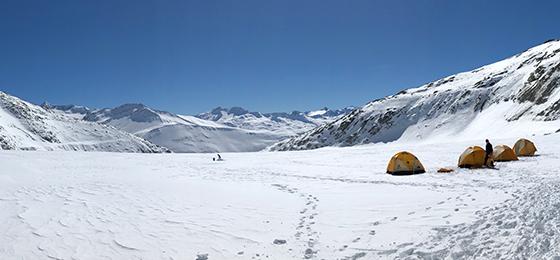Monitoring glaciers with optical fibres

Seismic monitoring of glaciers is essential to improving our understanding of their development and to predicting risks. SNSF Professor Fabian Walter has come up with a new monitoring tool in the form of optical fibres. The fibres are capable of monitoring entire glaciers.
Glaciers are constantly moving and they therefore need monitoring. Satellite images give clues to their development. By listening to glaciers from inside, seismology enables scientists to understand their movements with greater accuracy. However, because seismometers are difficult to install in glacial areas, seismic monitoring coverage of glaciers is patchy. In a recent study, Fabian Walter, SNSF Professor at ETH Zurich, demonstrated that it is also possible to monitor glaciers using optical fibres. Not only are the fibres easier to install than seismometers, they also offer more measuring points. They thus represent a way of extending seismic monitoring coverage in areas that are difficult to access.
One measuring point every two meters
The study, the results of which were recently published in the journal Nature Communications (*), took place at an altitude of 2,500 metres on the Rhone Glacier in the extreme north-east of the canton of Valais. For five days during March 2019, two teams led by Fabian Walter and Andreas Fichtner, a specialist in seismology and wave physics at ETH Zurich, recorded micro-earthquakes using a 1-kilometre fibre optic cable installed a few centimetres within the snow cover on the glacier surface. Distributed acoustic sensing was used to record disturbances in the optical signal – the result of seismic events within the glacier – at regular intervals of several metres along the cable. The recordings were converted into seismograms.
In his study, Fabian Walter reports that having a much larger number of sensors across the same monitoring area – 500 measuring points acted as sensors along the 1-kilometre cable – meant that the data obtained contained more information than those from seismometers, particularly as regards localising rockfalls and icequakes. Moreover, the cable delivered a better understanding of the jerky stick-slip movements by which the glacier moves. New types of seismic waves were identified, something that had not previously been possible with seismometers. Jerky movements of this type were already known to occur in the ice sheets of Greenland and the Antarctic, but this was the first time their existence was rigorously verified in the Alps.
What is happening inside the ice
Optical fibres are already used to monitor earthquakes in certain settings; but icequake specialist Fabian Walter is one of the first scientists to work with this technology on glaciers. “There are other teams already working on the subject – in Alaska, for example – because fibre optic technology offers benefits in this type of challenging environment,” explains the researcher, who conducted his study in partnership with the Swiss Seismological Service at ETH Zurich. “Whereas it often takes several hours to install a seismological station capable of covering only a tiny part of a glacier, all we have to do now is lay out the cable and we have hundreds of sensors. In theory, the technology enables us to cover and monitor entire glaciers.”
By measuring seismic velocities, the fibre optic cable also yields additional information, such as details of the composition of the ice. It also enables scientists to measure ice deformation rates and understand the process by which crevasses form.
Other applications remain to be tested outside glacier zones. Optical fibres are already available alongside roads and railways, and near to certain infrastructure installations. Dark fibre – in other words, optical fibres that have been installed but are not operational – could be used to monitor seismic events and prevent damage.
(*) F. Walter, D. Gräff, F. Lindner, P. Paitz, M. Köpfli, M. Chmiel, A. Fichtner: Distributed Acoustic Sensing of Microseismic Sources and Wave Propagation in Glaciated Terrain, Nature Communications (2020).https://doi.org/10.1038/s41467-
Contact
Promoting upcoming talent
The SNSF professorships, a funding scheme launched in 2000, has benefited 691 researchers. It was replaced by the SNSF Eccellenza scheme in 2018. Eccellenza Professorial Fellowships cover the assistant professors’ salaries and the costs of the project.
Links
- Download image for editorial use (JPEG): The scientists made their recordings at an altitude of 2,500 metres.
© Patrick Paitz - The project in P3, the SNSF’s research database
- Twitter SNSF